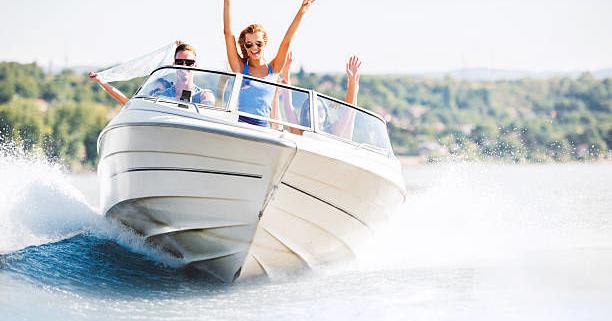Just one more week of school then it is unofficially Summertime!
With summertime comes lake time. The American Boating Association predicts that more than 100 million American adults will head to the water at some point this summer. That is roughly the population of California, Texas and New York, combined.
During the pandemic the recreational boating industry saw record sales. So much that manufacturers cannot keep up with the rising demand. New boat sales topped 320,000 in 2020, and 31 percent of those sales were to first-time boat buyers.
If you are one of those planning to pull the old Bayliner out and head for a day on the water, there are some things that need to be prepared first. Here are some tips for prepping one of the 15.8 million ski, bass, or jet boat for a day at the lake.
The American Boating Association (ABA) suggests that you create a pre-underway checklist like the Coast Guard Auxiliary has for their boat crews. Each time before an Auxiliary boat leaves the dock the entire crew reviews a standardized checklist together. Once all the items on the list are checked off it is time to get underway.
It does not have to be complicated; this is just an example of a pre-underway checklist you could use:
· Driver’s license
· Current registration papers and boating safety course completion card
· Check fuel supply and oil level
· Working proper navigation lights for night operations
· Enough lifejackets, the right size for all
· Marine radio
· GPS
· Float plan left in your vehicle or with a friend
· Other emergency equipment such as flares, first aid kit, signaling devices and tools
If something does not add up it is OK not to get underway. It is always better to choose safety than take a risk with your life or the lives of your passengers.
For those of you that own a boat, you know that there is literally hundreds of different products on the market for cleaning boats — and everything is “specific.” No one product will clean your whole boat; it takes an arsenal of products.
Here is a list of Do’s and Don’ts from myboatlife.com to get your boat ready to head to the lake.
Do these critical inspections:
· Oil and Filter Change — change your oil and filters every six months or after every 375 boating hours. (Whichever benchmark you reach first)
· Fuel Filter — change these filters every 12 months or after the completion of 100 hours of boating.
· Water Pump Service — service them every two months or after completing 200 hours of boating.
· Transmission Oil — change your transmission oil once in 24 months or after the completion of 2000 operational hours, whichever benchmark you reach first.
· Clean Air Filter — clean them every six months or after 1000 hours of operation.
· Steering Cable Grease — you must grease this one up every 12 months. A recommendation is to do so at the beginning of the boating season.
· Battery Charge — you can do this either every 12 months or if the battery indicator shows low sign. Sometimes battery charge can drop due to no-use. So, stay on top of this if you do not want to get stuck in the middle of no-where.
· Check Prop — pre and post check for each time you take your boat out for a spin.
Next, let’s talk about cleaning that winter dust and grime off of your boat. Motor Boatin’ magazine offers these tips to make your boat look like new. A clean boat will last you longer than a dirty (unprotected) one. UV rays, water minerals, oxidation; all of these will slowly break down your boat and keeping it clean will easily prevent these problems.
· Boat upholstery: Use the right type of brush to address stubborn dirt. Do research on the best cleaners for each type of upholstery. Using the correct materials helps shorten the cleaning process while also making sure the cleaner used is not causing damage.
· Windshields: Use window cleaning solution with a soft cloth to clean off window stains. The cloth helps to prevent streaks. Clean windshields when it is cooler outside and the windshield is out of direct sunlight.
· Deck: Use a hose and a boat cleaning solution for the boat deck. Measure out the correct proportion of water to cleaner. Use a brush to get difficult dried on dirt and stains out.
· Exteriors: Use a hose with a nozzle that propels more water over a larger surface, but it is NOT a pressure/power washer. If it is the type of hose that already mixes in the cleaner, measure out the proportions correctly. Use buckets with a water and cleaning solution and a sponge to get to harder to clean spots. Rinse throughout the process to prevent the sun from drying the cleaner’s solvents onto the boat. Use soft and absorbent towels to dry off the boat. Use the appropriate wax and wax amount to seal the boat against the sun’s rays and water’s corrosive properties.
· General: As always, it is good to have a cleaning kit on board for messes and spills. Keep some cleaning wipes, window cleaner, paper towels, and cloths for quick fixes.
Required equipment- Now that you have got everything all spiffy, it’s time to think about eh making sure your boat is legal. Oklahoma boating laws requires some items for most powered watercrafts, including personal watercrafts (PWC), boats under 16-feet, and boats over 16-Feet. Here is the checklist of what you need to have:
All watercraft on public water have to have certification numbers
Other required validation decals must be displayed
All watercraft must have (and be worn) personal flotation devices (PFD) 1 for personal water craft, 2 for others
Boats over 16-ft must have a throw type PFD
Children under 13 must wear a PFD whenever a boat is underway
Those on a PWC must wear a FPD at all times
All watercraft must have a type B-1 fire extinguisher
All watercraft must have a horn, whistle or bell
Southwest Fishing Report
Altus-Lugert: Elevation 23 ft. below normal, water 67 and stained. No fishing activity.
Ellsworth: Elevation 3.5 ft. below normal, water 60 and murky. Crappie fair on jigs, minnows around brush, docks and rocks. Sand bass and saugeye good on crankbaits and small lures round docks, main lake and rocks.
Fort Cobb: no report
Lawtonka: Elevation 3 ft. below normal, water 61 and clear. Crappie fair on jigs, minnows around brush, docks and rocks. Saugeye fair on crankbaits and small lures in main lake.
Tom Steed: Elevation 6 ft. below normal and falling, water 69 and murky. Sandies and Hybrids excellent on crankbaits, jigs and shrimp in main lake points and shoreline. Catfish excellent on cut bait and stinkbait. Crappie good on jigs, minnows around brush, rocks and shallows. Saugeye good trolling crankbaits.
Waurika: Elevation 2.5 ft. below normal, water 68 and murky. Hybrids and sand bass fair on flukes, sassy shad around main lake points. Crappie fair on jigs, minnows around brush. Catfish fair on cut bait, shad, stinkbait around main lake points.
Want to reach a local audience and grow your business?
Our website is the perfect platform to connect with engaged readers in your local area.
Whether you're looking for banner ads, sponsored content, or custom promotions, we can tailor a package to meet your needs.
Contact us today to learn more about advertising opportunities!
CONTACT US NOW






